Photographs: Roy Madhur/Reuters
"Here is a small piece of land where angels fear to tread. It is full of innumerable landmines".
This is how Justice Sibghat Ullah Khan described the Ram Janmabhoomi-Babri Masjid dispute in a prelude to his judgment. He compared it to a 1,500-sq yard minefield which he and his brother judges had to clear.
'We do not propose to rush in like fools'
Image: Pilgrims walk towards the Ram temple as a policeman stands guard in AyodhyaPhotographs: Adnan Abidi/Reuters
"Here is a small piece of land (1,500 square yards) where angels fear to tread. It is full of innumerable landmines. We are required to clear it," he said.
"Some very sane elements advised us not to attempt that. We do not propose to rush in like fools lest we are blown up. However, we have to take the risk. It is said that the greatest risk in life is not daring to take a risk when the occasion for the same arises," he wrote.
'Have we succeeded or failed?'
Image: Muslims hoist a black flag atop a mosque in AyodhyaPhotographs: Reuters
The judgment on Thursday that ran into 285 pages says that judges cannot decide whether they had succeeded or failed in their attempts.
"Once angels were made to bow before man. Sometimes he has to justify the said honour. This is one of those occasions. Have we succeeded or failed? No one can be a judge in his own cause," he said.
The prelude concludes with, "Herein follows the judgment for which the entire country is waiting with bated breath."
'There was neither existence nor non-existence'
Justice Sudhir Agarwal, who had written the lengthiest judgment, began by quoting extensively from the Rig Veda, with verses referring to the destruction and the subsequent creation of the universe.
"During the Dissolution, there was neither existence nor nonexistence, and at that time neither Lok (world) was there nor was anything beyond the space. What encompassed all at that time? Where was the abode and of whom? What was the unfathomable and deep water," he quoted from the Vedic text in the beginning of his judgment.
'There was neither death nor immortality'
Justice Agarwal, whose judgment ran into 21 volumes and more than 5,000 pages, further quoted, "None knows and none can tell as to from where and how the Creation took place, because even the scholars or those having foresight were born after the Creation. Hence, none knows the source of this Creation."
"At that time there was neither death nor immortality, and there was also no knowledge of day and night in the absence of the Sun and the Moon. In that stage of vacuum, Brahm (the Supreme Being) alone was imbibing life from His own power. There was nothing beyond or distinct from Him," he said.
Justice Dharam Veer Sharma had no such preludes and opted to address the issue straightaway.
Temple pillars used to make Babri Masjid: Judge
Image: A demonstration to demand the construction of the Babri MasjidPhotographs: Reuters
Remnants of demolished Hindu temples were used to build the Babri Masjid, Justice Dharam Veer Sharma of the Lucknow bench of the Allahabad high court has held and cited evidence provided by the Archeological Survey of India to support the findings.
"On the basis of circumstantial evidence, historical accounts, gazetteers 361 and other epigraphical documents, it is established that after demolishing the temple, the disputed structure was constructed as a mosque and even pillars of the old temple were re-used, which contained the images of Hindu gods and goddesses against the tenets of Islam," he said in his judgment on Thursday.
'The oral evidence led by Muslims is not trustworthy'
Image: A demonstration to demand the construction of Ram TemplePhotographs: Reuters
"Thus, the circumstantial evidence totally contradicts the assertion of Muslims. I have already referred the oral evidence, adduced by the parties in Annexure No.5, I conclude that the oral evidence led by Muslims is not trustworthy. Thus the circumstantial evidence conclusively established the claim of Hindus about the destruction of old temple and construction of Babri mosque at the site of the temple, which is corroborated by the expert evidence of the ASI," he said.
According to the judge, the 265 inscriptions found on December 6, 1992 after demolition of the disputed structure, along with other architectural remains, leave no room for doubt that the inscription is written in the script of Devnagri of 11th and 12th century.
'The temple was demolished and the mosque was constructed'
Photographs: Reuters
"I have also referred English translation of 20 line inscription of Dr K B Ramesh. The aforesaid circumstantial evidence supported by other epigraphical documents are the most valuable evidence which fully corroborate the version of Hindus and belies the version of Muslims that the mosque was not constructed after demolishing any temple," the judge said.
The judge added, "On the basis of the opinion of the experts, evidence on record, circumstantial evidence and historical account from all or any angle, it transpires that the temple was demolished and the mosque was constructed at the site of the old Hindu temple by Mir Baqi at the command of Babar."

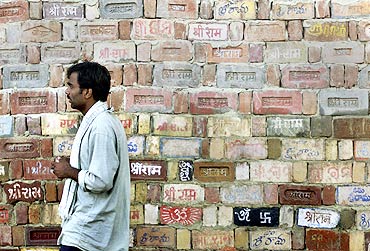
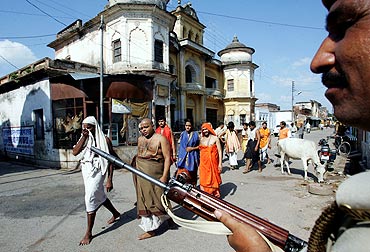
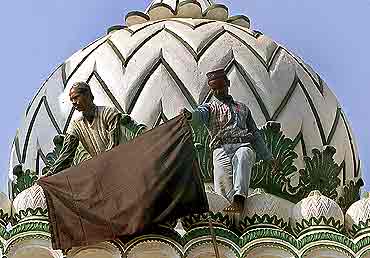
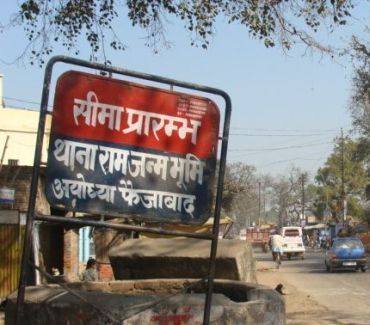
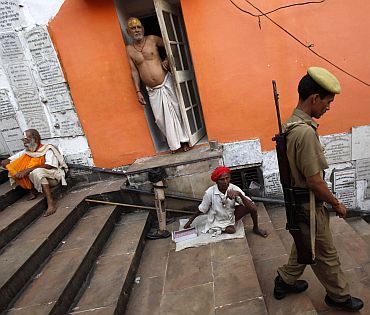

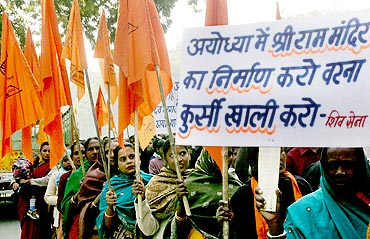
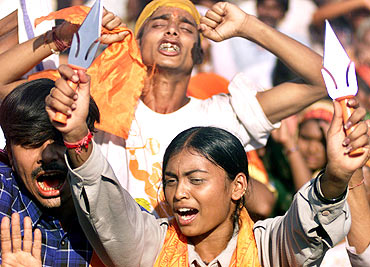
article